Vital valley village Glenboro residents embrace peaceful lifestyle in Westman crossroads and farming hub
Read this article for free:
or
Already have an account? Log in here »
To continue reading, please subscribe:
Monthly Digital Subscription
$0 for the first 4 weeks*
- Enjoy unlimited reading on winnipegfreepress.com
- Read the E-Edition, our digital replica newspaper
- Access News Break, our award-winning app
- Play interactive puzzles
*No charge for 4 weeks then price increases to the regular rate of $19.00 plus GST every four weeks. Offer available to new and qualified returning subscribers only. Cancel any time.
Monthly Digital Subscription
$4.75/week*
- Enjoy unlimited reading on winnipegfreepress.com
- Read the E-Edition, our digital replica newspaper
- Access News Break, our award-winning app
- Play interactive puzzles
*Billed as $19 plus GST every four weeks. Cancel any time.
To continue reading, please subscribe:
Add Free Press access to your Brandon Sun subscription for only an additional
$1 for the first 4 weeks*
*Your next subscription payment will increase by $1.00 and you will be charged $16.99 plus GST for four weeks. After four weeks, your payment will increase to $23.99 plus GST every four weeks.
Read unlimited articles for free today:
or
Already have an account? Log in here »
Hey there, time traveller!
This article was published 06/10/2023 (793 days ago), so information in it may no longer be current.
GLENBORO — It’s 1:30 p.m. and the dining room at Spruce Woods Inn is abuzz with chatter. In the kitchen, Lisa Park, who owns and runs the motel with her husband Jim Choi, is busy whipping up omelettes, sandwiches and milkshakes for the hungry lunch crowd.
“Try the soup,” Charlotte Adam, Glenboro’s postmaster recommends. “It’s homemade and usually very good.”
Adam, newly engaged to fellow diner Heinz Hermann, is a regular at Glenboro’s only sit-down restaurant, which is attached to the 14-room motel.
It’s a full house this late September afternoon, and the server is rushed off her feet as orders come in thick and fast.
Today’s soup is turkey and vegetable, comforting and studded with meat and root veggies. The BLT is generously stuffed; the bacon is crispy, lettuce crunchy, tomatoes firm. A little jug of piping hot coffee completes the meal; it’s simple, satisfying fare you’d expect from a small-town diner.
Park and Choi have lived in Glenboro for 11 years now. The couple, originally from South Korea, raised their sons Jay and John in the southwestern Manitoba town. Their boys graduated from Glenboro School and completed their degrees at the University of Manitoba before moving to Ottawa.
“Jay just graduated and John is doing computer science,” Choi says proudly.
The boys make sure to return to the family home, just five minutes down the road from the hotel, at least once a year.
Open seven days a week except on official holidays, the restaurant and adjoining bar area seats 104 people. The hotel with its seven single and seven double rooms is especially busy in the summer with visitors heading to the nearby Spruce Woods Provincial Park.
RUTH BONNEVILLE / WINNIPEG FREE PRESS Glenboro residents gather for lunch at the Spruce Woods Inn, the only eat-in restaurant in the town.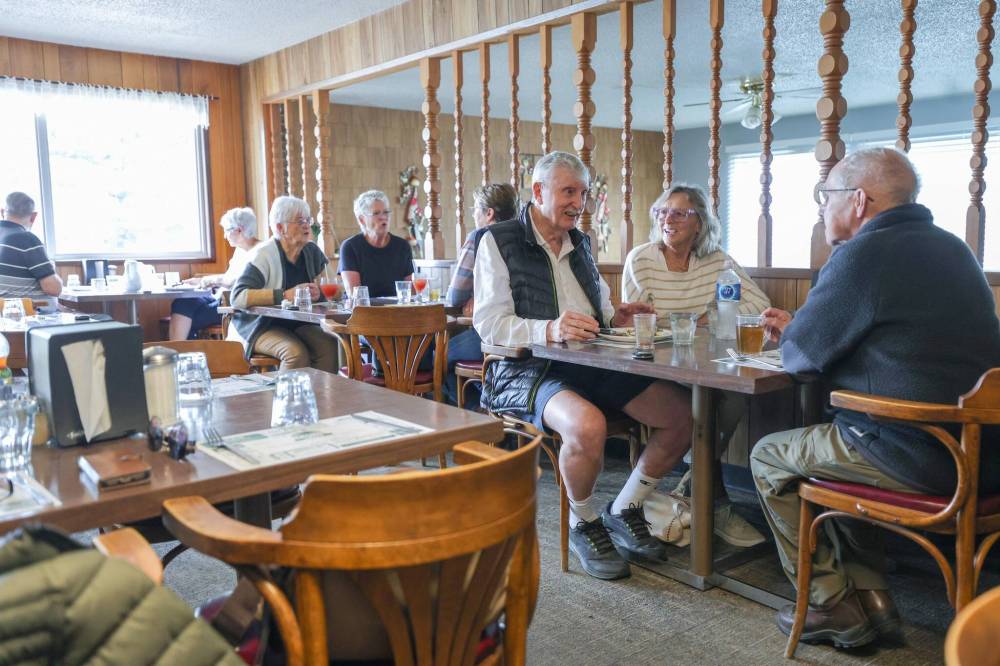
Choi and Park took over running the hotel from previous owners Bill and Cindy Skanderberg.
“We moved to Glenboro on Dec. 26, 2012, and in January 2013 I started my business officially,” Choi explains.
“Our location is very good. We have local people eating, we have travellers and we have people working in construction. I am happy. This is a good business for me.”
He says he loves the village and appreciates the stability it offers.
“This is a farming area and farmers are very good and kind to everybody. Everyone is friendly; this is another reason why I chose this town. There is no crime, there are no gangsters. Almost nothing bad happens here.”
Located approximately 170 kilometres west of Winnipeg, present-day Glenboro, nestled at the junction of highways 2 and 5, is surrounded by potato, wheat, sunflower and canola fields.
This is farming country and agriculture, although recently displaced by manufacturing, is still one of the top economic drivers for Manitoba.
Fields are dotted with combines and other pieces of heavy farm machinery, while trucks laden with potatoes zoom down the highway.
So, it’s a rather incongruous sight when a 17-foot, 2,000-pound camel suddenly appears on the side of the road.
RUTH BONNEVILLE / WINNIPEG FREE PRESS Former Glenboro mayor Earl Malyon with the village's mascot, Sara the Camel, in 1978. Standing 17 feet tall and weighing more than 2,000 pounds, Sara was designed by sculptor George Barone.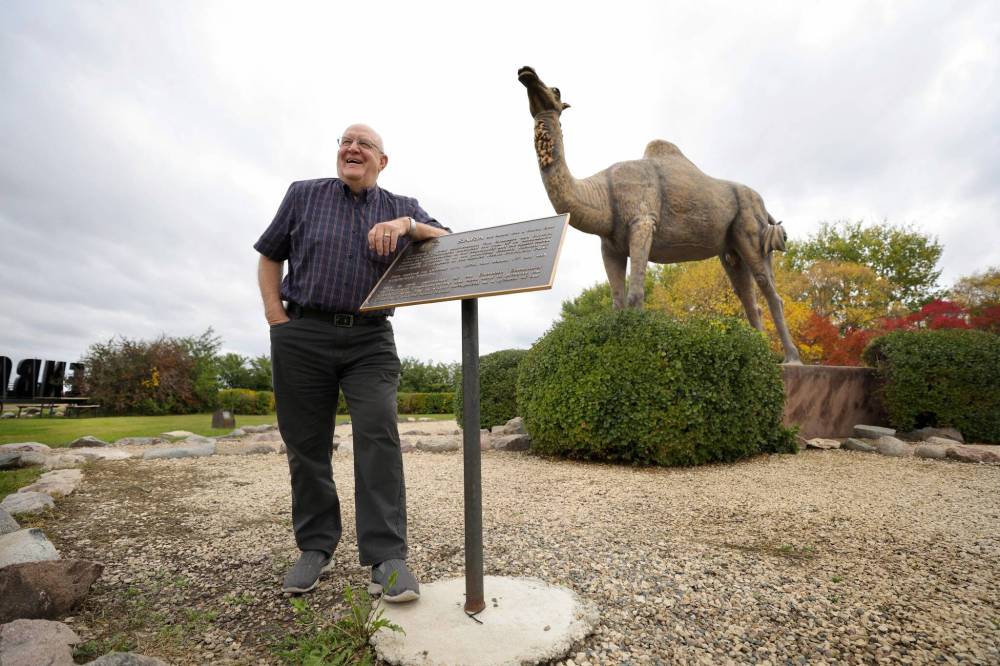
As strange as it sounds, Sara the Camel is easy to miss when you’re driving down Highway 2 in the fall when the fields are a dusty brown and the foliage turns to shades of yellow, orange and red; the sandy hues of the sculpture meld into the surroundings, making her almost invisible to the eye.
Commissioned by the Glenboro Chamber of Commerce in 1978, opinions were divided as to why the village needed a camel to represent it. Today, however, Glenboro is proud of its one-humped mammal emblematic of the Spirit Sands — commonly referred to as the Manitoba Desert (though, technically not really a desert) — located 12 kilometres north of Glenboro.
“It’s the same old story. Fifty per cent of the people were in favour and 50 per cent weren’t and it turned out that it’s been a good asset to our community. Everybody in the countryside knows that we are the camel people,” Earl Malyon, former mayor and lifelong resident, laughs.
Malyon, 80, can trace his descendants back to the first wave of village settlers. If there’s anyone who knows this village, it’s him.
He served on the municipal council for 41 years, working his way up from councillor to deputy reeve to reeve and finally becoming mayor of the amalgamated municipalities of Glenboro, Stockton, Treebank and South Cyrpress before retiring six years ago.
“My ancestors were some of the pioneers here,” Malyon explains.
“I live on the farm my grandparents Osborn and Olive Malyon bought. Grandmother Olive was a Douglas, part of the first or second wave of settlers that came here in 1881. The original quarter section was bought in 1897. I’ve since sold it all but I live in the original farmyard.”
“My ancestors were some of the pioneers here.”–Earl Malyon
Located on Treaty 1 land, long before European settlers first set foot in the area, the village now known as Glenboro sits on the ancestral lands of the Anishinaabe and Swampy Cree.
In 1879, European settlers Jonas Christie and James Duncan made their way to Manitoba from the United States, establishing their point of operations in the community of Holland, 30 kilometres to the east, before setting off by foot to Glenboro in November of that year.
The duo selected their homesteads before returning to Holland to spend the winter. The following spring they came back to build their homes there.
More settlers followed, often walking for miles with their wagons, which they lived under, until they were able to break ground to build sod houses.
The arrival of the Canadian Pacific Railway in 1886 prompted Christie and Duncan to offer the CPR the north half of their section of land if they would locate the village there.
RUTH BONNEVILLE / WINNIPEG FREE PRESS Railway Avenue, where a thrift store now stands.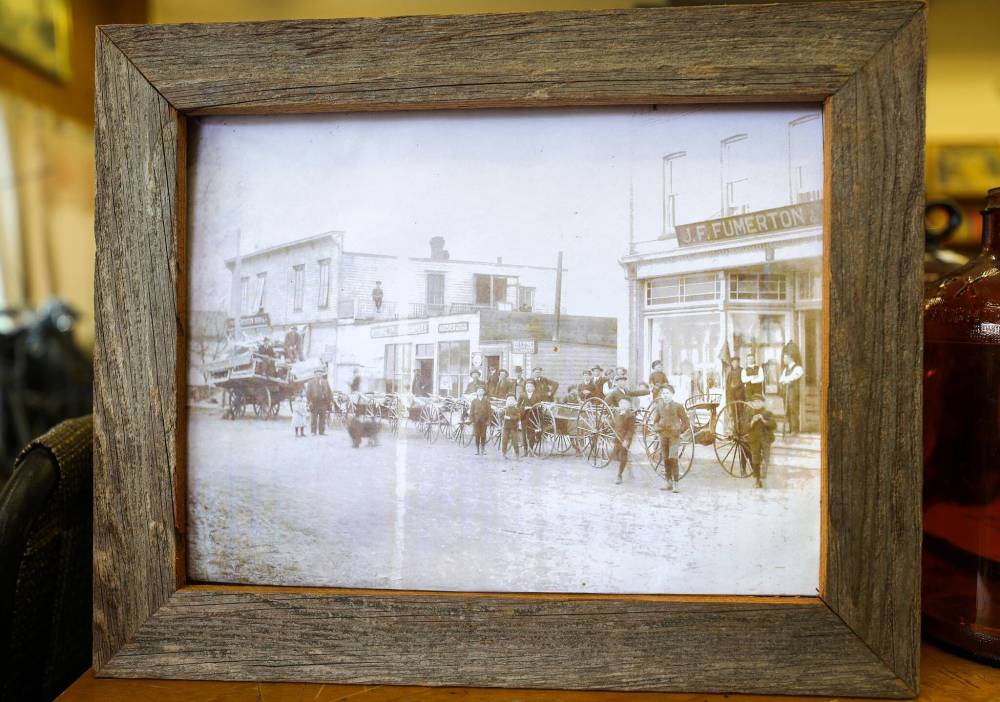
It was duly christened Glenboro, from the Scottish term burrough of the gleann (meaning “town of the valley”), by Duncan.
The new township also attracted residents of nearby Millford, who moved themselves and their buildings to the growing area. Once the CPR decided to bypass Millford, the town faded from existence. By 1894, Glenboro’s population reached 500 and a host of new businesses, including four general stores, two livery stables, two harness shops, a flour mill, two veterinary surgeons, a jeweller, four milliners and three dressmakers had been established.
The roads may have been made of mud and sidewalks were just planks, but the village was growing rapidly.
Sod houses were replaced by homes built of logs cut near the Assiniboine River and soon the village even had its own newspaper, the Glenboro Gazette, edited by a man called Lumly.
A two-room school was built in 1881 and further classrooms were added in subsequent years.
The modern equivalent, built in 1960 with additions in 1969 and 1973, is home to 176 students, from kindergarten to Grade 12.
On this day, a group of first- and second-graders are being shown around the Burrough of the Gleann Museum by museum chair Myrtle Nichols. Located on Broadway Street, one of two business streets in Glenboro, the museum is a treasure trove of historical artifacts, donated by village folk.
RUTH BONNEVILLE / WINNIPEG FREE PRESS The Burrough of the Gleann Museum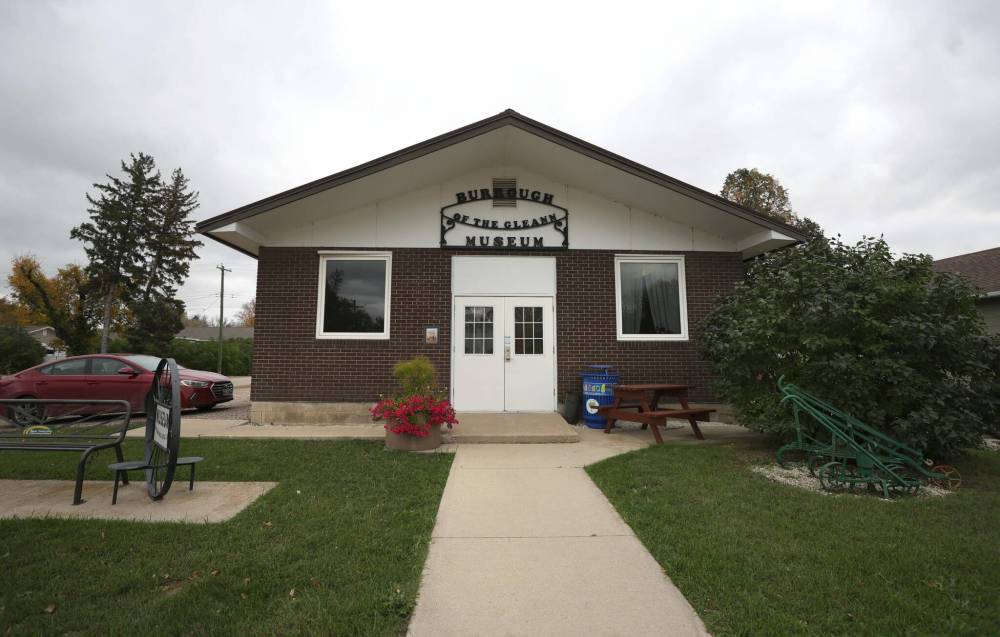
The youngsters, accompanied by teachers Jenna Cullen and Michele Wytinck and teaching assistant Tammy Cronin, troop dutifully after Nichols as she moves through the spaces, listening in rapt attention as she speaks.
They have fun guessing what a chamber pot is and a chorus of giggles ensue when Nichols explains its use.
Housed in the former Prairie School Division Office, the museum was spearheaded by Glenboro resident Ernestine Sepke, with the help of Elsie Pinkerton, Lillian Blaine and Jacquie George.
The main floor features an old-fashioned kitchen, dining room, parlour, bedroom and general store complete with a post office and telephone switchboard.
In the basement, there are displays of early tools used for farming and a section highlighting the different businesses that used to be in Glenboro including a barbershop, dentist’s office and milliners.
Nichols, who moved to Glenboro in 2005, took over as chair of the museum board in 2017.
“I really value it. When you see all the history that is there, that needs to be preserved… because if not it will all be gone,” she says.
The board is composed of four volunteers — “volunteering is really important in smaller communities,” Nichols says — who meet monthly to divide responsibilities and discuss changes to displays.
“Some of the exhibits we rotate but that is our basic design, although we do play around with it. It’s a work in progress. The museum has evolved over the years and it is still evolving,” she says.
Almost every item displayed has been donated by area residents. As well as the aforementioned chamber pots, there are handmade musical instruments, crockery, clothing and furniture.
A few doors down from the museum is another repurposed building, serving the municipality’s 1,565 residents with a steady diet of fiction and non-fiction. The Glenboro/South Cypress Library, housed in what used to be the village telephone exchange, holds around 8,772 books, which are looked after by librarian Kelly Tirschman, who also organizes reading programs for the community, plus children’s activities in the summer.
RUTH BONNEVILLE / WINNIPEG FREE PRESS Librarian Kelly Tirschman in front of the Glenboro/South Cypress Library.
“The library is part of the Western Manitoba Regional Library System based out of Brandon,” says library board member Donna Fillion. “We are one of the six regional libraries branches. We can access books from any of the other branches and order them in.”
Fillion works in the municipal office on Railway Avenue, the village’s second business street, and has lived here for 33 years with her husband, Lee. The couple’s mothers are also residents.
She loves living in Glenboro, citing its amenities, her family’s church and the village’s “quietness” as reasons she and her family remain here.
“Life is very laid back. I grew up in the country so it is what I was used to. I love the sense of community that people have. I know that my kids were safe when they were out and about. I love the proximity to Spruce Woods Park, we use the trail systems there a lot.”
RUTH BONNEVILLE / WINNIPEG FREE PRESS Open four days a week — Friday to Monday — the theatre is headed by volunteer committee of five and is run by students.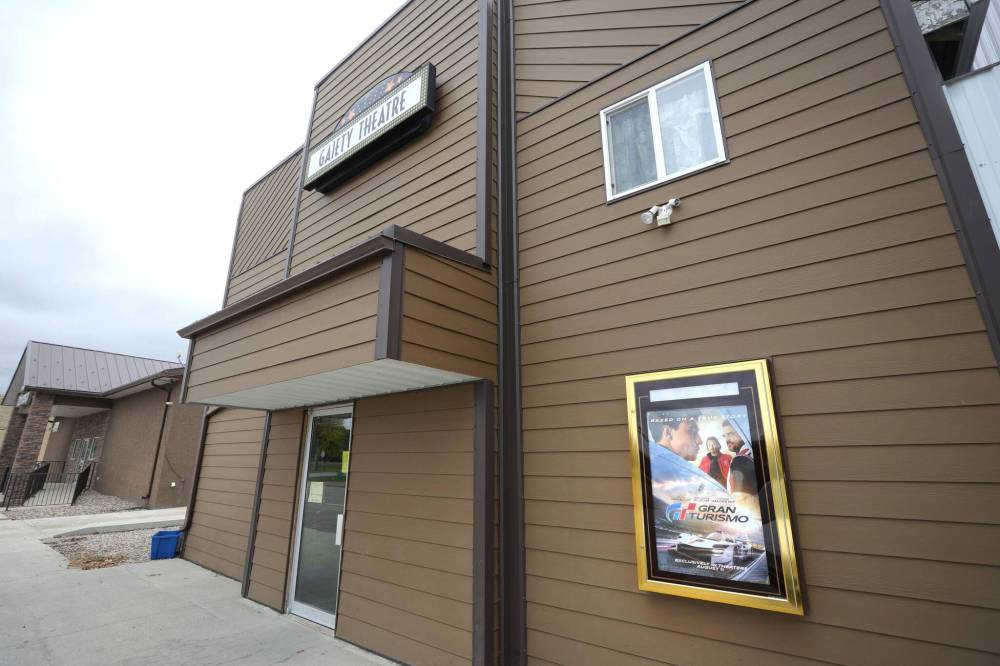
For a village with just 624 residents there is certainly plenty to do, not least being the Gaiety Theatre, which opened its doors in 1945. Open four days a week — Friday to Monday — the theatre is headed by volunteer committee of five and is run by students.
This weekend the 150-seat cinema will be screening PAW Patrol: The Mighty Movie.
Village resident Jodise Ruston used to work there when she was a student, as did her own children. Now she oversees the operation of the theatre.
“I’ve come full-circle,” she laughs. “I actually only did the concession and the ticket sales. I never got too involved with the projector. We used to have one guy who ran the projection, he got paid $25 for the weekend and he did it until he was almost 90! Then we got a replacement guy and he did it until he was 92! When they left we got younger people in.”
The theatre hires nine part-time students who are paid a small wage to run the concessions and the digital projector.
“We want our kids to have jobs. There aren’t many jobs in Glenboro: there is the gas station, the Co-op, and the park in the summer. Here these kids can have jobs all year long. We do birthday party rentals, we try to do other fundraisers that we can make money on,” Ruston says.
Ruston wishes the cinema could run more than one movie a weekend, but bemoans the fact the studios won’t let her. She says it would mean more bums on seats.
Ticket prices are reasonable: $6 for adults, $5 for students and $4 for children. Snacks are also affordable: a large popcorn will set you back $5 and all chocolate bars and drinks are $2. Bottled drinks are $3.
RUTH BONNEVILLE / WINNIPEG FREE PRESS Glenboro’s Gaiety Theatre first opened in 1945.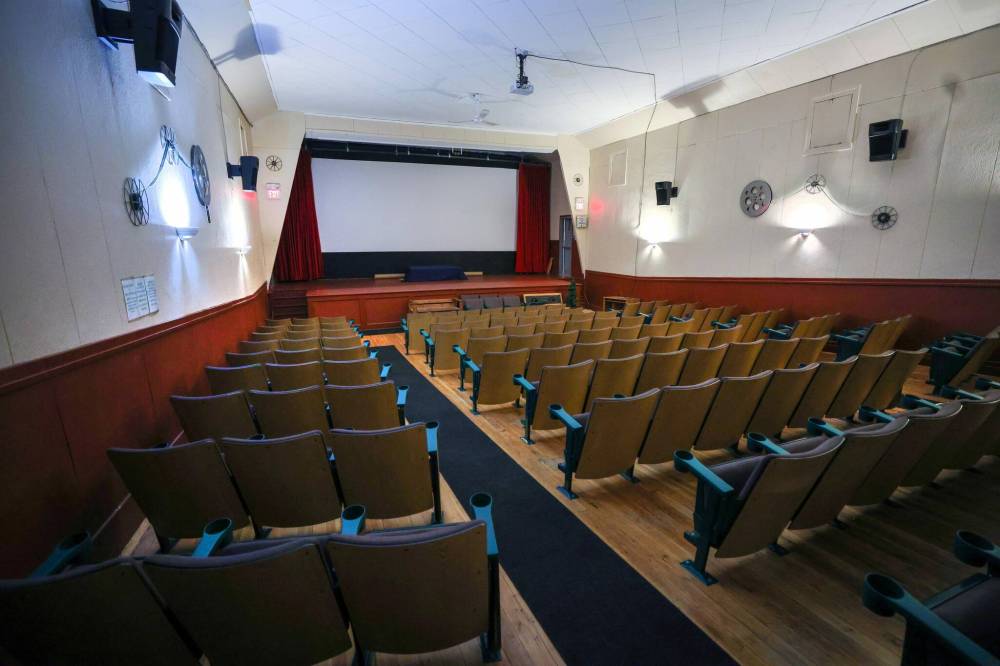
“We keep our prices low because we want people to come,” Ruston says. “Everyone has big screen at home and it’s tough. We have to compete with everything. We want people to come out, we don’t want them to say ‘we can’t afford it.’”
On the same road as the cinema is a relatively new business, Rimmer Technology, which builds agricultural-based software. Across the road is a small green with a few benches.
In the middle sits a three-foot-high bronze sculpture of the former wooden CPR water tower which, in an act of vandalism, burned down on April 4, 2008. It’s the vision of world-renowned sculptor Peter Sawatzky.
Originally from Sommerfeld in the Red River Valley, the sculptor used to spend his teenage summers in the Glenboro area because he would hang out with his cousin on his uncle’s nearby farm. In 1976, he moved to the Glenboro area with his wife and infant son.
“I loved coming out here, it’s such a beautiful place. I’ve been doing artwork ever since I can remember and I pursued commercial art in Red River College. I lived in Winnipeg for five years. When my son was born I didn’t want to raise him in the city and that’s why we moved here.”
He created the water tower for sentimental reasons, he says.
“I approached the village after the original water tower was torched by kids and offered to make it for them,” says Sawatzky, who is well-known for creating large-scale works of art in bronze.
“I felt sorry for the village. It was a very historic tower, a real shame that it burned down. It was one of the last working water towers in Canada. I did a lot of research on this, I spoke to an old guy who was a station manager and he showed me a lot of pictures and I worked on it from there.”
Sawatzky still lives in Glenboro, and works in a studio just outside of town. The place is perfectly suited for what he does.
“I love the area. It’s centrally located, it has a huge variety of habitation and birds and animals. I have travelled all over the country and world and I still think this is one of the nicest and most beautiful place for one to live,” he says.
”I have travelled all over the country and world and I still think this is one of the nicest and most beautiful place for one to live.”–Peter Sawatzky
But there are also disadvantages to living rurally, he concedes. Like most small towns, Glenboro has seen its fair share of changes and not all of them positive.
“We have lost a number of businesses. They closed the railways here and we lost three grain elevators. It takes a lot of employment away for the people who work here. The population has remained very similar through the years but losing the number of businesses has hurt the town,” he says.
Residents also worry about the possible closure of the hospital when their doctor, Dr. Walther Swanepoel, who has been working at the medical centre for 25 years, retires at the end of the month.
It’s a fear that plays on Glenboro Mayor Charles Radford’s mind.
“The doctor and nurses are coming to retirement age,” he says.
“We are serving a fairly large community with just one doctor and nurse practitioner. We need at least two full-time doctors to be fully functional.”
Lack of access to emergency services is another concern: currently they are on limited hours of Tuesdays only.
“This is one of the major disadvantages of living here; if you have an issue you don’t always have emergency access to the hospital. Also if you need police help, the nearest police are an hour away, at minimum,” Sawatzky continues.
But for all their worries, almost every resident says the advantages of living in Glenboro far outweigh the disadvantages.
“It’s just peaceful,” Sawatzky says. “You know the old song, Peaceful Easy Feeling? That’s what it is.”
Drive approximately 12 kilometres west of Glenboro and things are far from peaceful.
Loud, grunting noises break the silence. Thick, early morning fog obscures the way.
The trees are in their full autumn splendour; shades of orange and yellow flutter onto the dew-soaked grass; it’s bucolic and nightmarish all at once.
The grunting noises morph into a shrill screech before fading into silence.
The Assiniboine River appears suddenly as the road drops and turns.
The source of all that shrieking comes into focus: a mid-sized bright yellow Komatsu bulldozer making its way onto the steel hull of the Stockton Ferry.
RUTH BONNEVILLE / WINNIPEG FREE PRESS The Stockton Ferry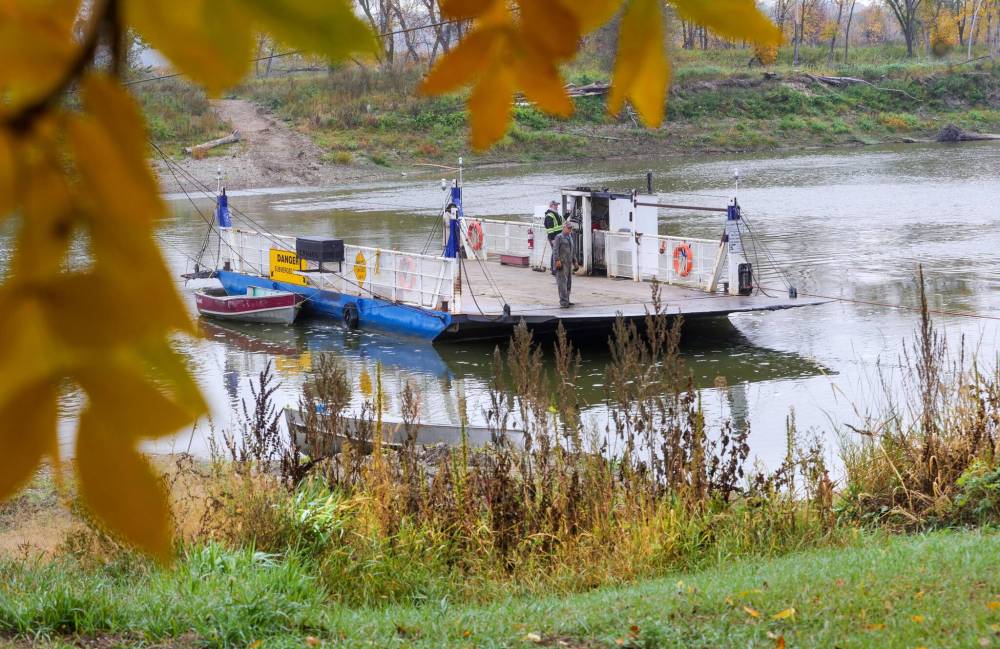
Ferry operator Eva Stoewer starts the ferry’s two-geared Honda engine to take the bulldozer across the river. Exactly a minute and 28 seconds later the machine trundles up the opposite bank, having safely made the crossing.
Stoewer has been working the ferry since August 2022. It’s a seasonal job running from April 1 to Nov. 1 … unless of course the river floods. Then, as it did in 2011 and again in 2014, the ferry doesn’t run at all.
It’s busiest during harvest and seeding times, when crossings take place all through the opening hours of 7-11 a.m. and in the afternoon from 3-7 p.m.
“The locals cross all the time; this is like a bridge for them. There are people farming on the other side, they have land on both sides of the river, so they use this sometimes more than 10 times in a day,” she says, raising her voice above the chug-chug-chug of the engine.
“Everything has to be organized around the river if you are farming around here.”
The mechanism on the engine is simple: there are two gears, one to make the ferry go across the river and one to bring it back to the west side. An orange cable moored on the west side of the riverbank guides the platform.
RUTH BONNEVILLE / WINNIPEG FREE PRESS Dale Miller uses the ferry to haul his bulldozer across the river. The Stockton Ferry is the last operational ferry in southern Manitoba.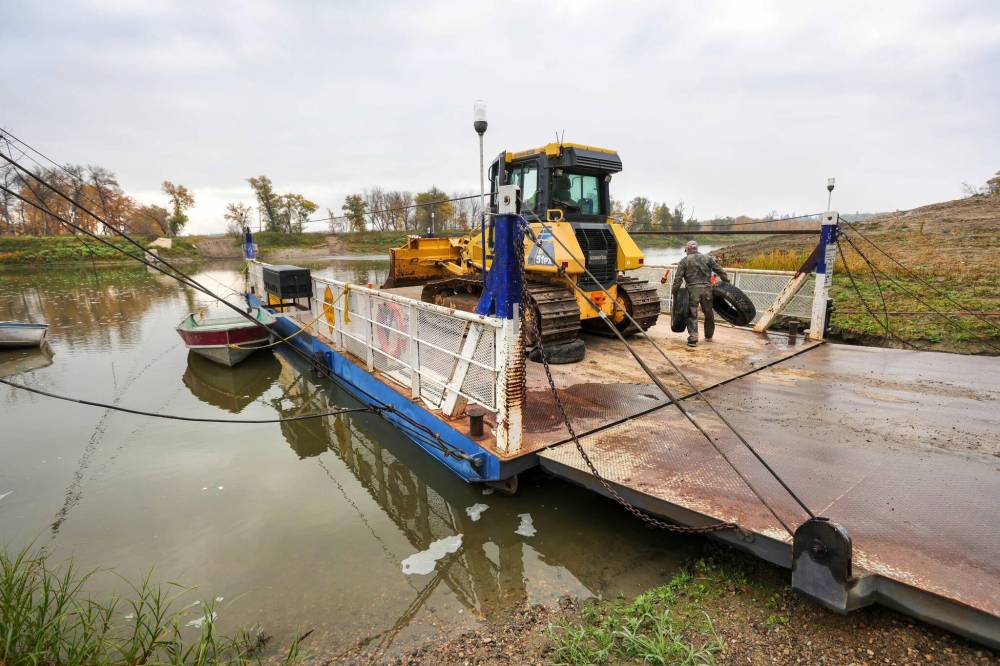
When it first opened in the 1800s, the Stockton Ferry Crossing was considered a community hub. In the summer, villagers would organize parties and dances on the banks. One of 150 ferry crossings in Manitoba, crossings like this one played an important role in towns that didn’t have railways lines or bridges.
Not anymore; this is the last operational ferry in southern Manitoba.
The Stockton Ferry first made its appearance in 1887. Although the original wooden scow is long gone and an engine now powers the metal machine, not much else has changed since the early days.
Back then a movable cable, angled across river, harnessed the currents to pull the scow.
In 1945, a new ferry, with a wooden hull and deck, did double duty as passenger and vehicle ferry. It remained cable-powered until 1960 when it was upgraded with a three-brake horsepower gasoline engine. Since then there have been two more versions — the Aubigny Ferry brought in from the ferry crossing of the same name ran from 1966 to 1989 before the current version, formerly known as the Treesbank Ferry, began its river crossing duties.
“We have around 25 crossings or so a day nowadays,” Stoewer says. “We also have visitors who park their cars, they have a picnic here and they go across and come back. Sometimes people camp on the banks of the ferry crossing — you are allowed to do that.”
RUTH BONNEVILLE / WINNIPEG FREE PRESS Ferry operator Eva Stoewer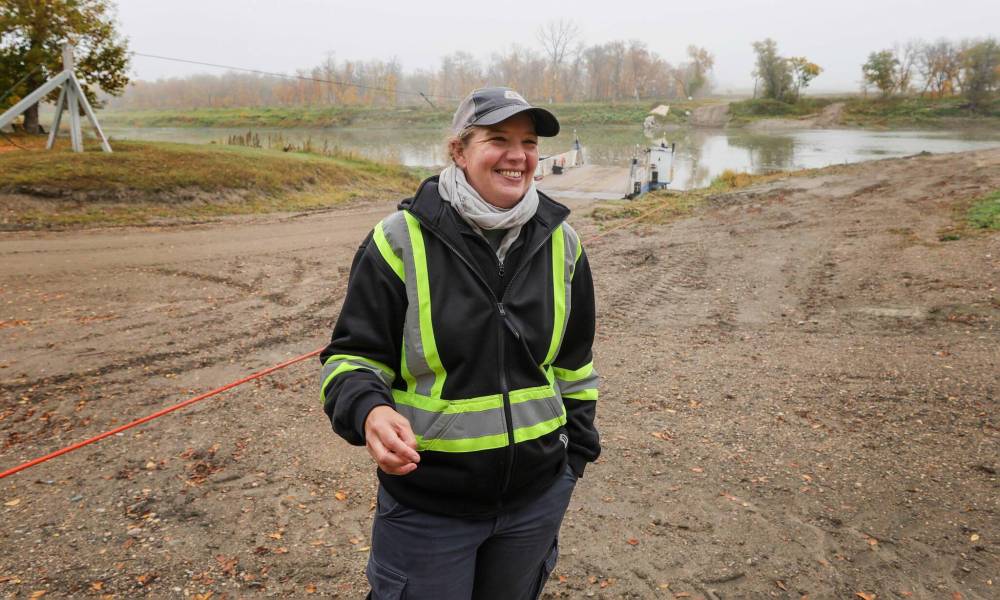
The area was beautified in 2022, thanks to a grant from the province and now boasts a large pergola, which acts as a picnic space complete with picnic tables and a community firepit as well as a picture wall detailing the history of the ferry crossing. Designated fishing sites, equipped with benches and fishing tables, have also been added along the banks of the river.
It can be a lonely job; as the season winds down Stoewer often has periods where she sees hardly anyone during her working hours.
However there’s one person whom she can count on to make the crossing, sometimes several times a day. Neilie Cremin, a beef cattle farmer, and her husband use the ferry to haul hay across the river.
“The ferry is necessary and useful; there is no other way to get there. We can do this in less than five minutes; the other way is to drive around to the bridge between Wawanesa and Shilo and it would take a couple of hours,” Cremin says.
There’s a month more of crossings before it’ll be too cold for the ferry to run.
Before the river freezes fully, the ferry is pulled up to the parking lot where it sits and waits, remaining silent until the spring thaw arrives. Then the chug-chug-chug kicks up and the area is once again bustling with activity.
av.kitching@freepress.mb.ca

AV Kitching is an arts and life writer at the Free Press. She has been a journalist for more than two decades and has worked across three continents writing about people, travel, food, and fashion. Read more about AV.
Every piece of reporting AV produces is reviewed by an editing team before it is posted online or published in print — part of the Free Press‘s tradition, since 1872, of producing reliable independent journalism. Read more about Free Press’s history and mandate, and learn how our newsroom operates.
Our newsroom depends on a growing audience of readers to power our journalism. If you are not a paid reader, please consider becoming a subscriber.
Our newsroom depends on its audience of readers to power our journalism. Thank you for your support.
History
Updated on Friday, October 6, 2023 3:17 PM CDT: Updates cutlines





